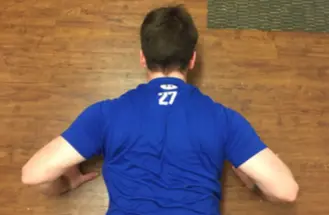
Jan 30, 2017 • 4 min read
Coaching the Pushup for Long-Term Success
I’m a big believer in using practice time to teach young athletes basic strength exercises. Youth practices are often a kid’s first formal exposure to strength training. As a coach, this is an incredible opportunity to help athletes build good habits that will set them up for long-term success.
For example, the pushup is a great prerequisite to bench pressing, which is the preferred exercise amongst many high school athletes. Even if a young athlete does not end up playing sports in high school or beyond, teaching a kid how to properly perform a pushup will create a foundation for good exercise habits that last a lifetime.
While commonly used as a form of conditioning and strength building, pushups are too often performed with poor technique. Many coaches have players do 10-20 pushups without considering whether their athletes can even perform one proper pushup. With that being said, let’s break down what usually goes wrong with pushups, and how you can teach proper pushup techniques.
The most common flaw I see among young athletes are pushups that look like Ts instead of Vs. When you look down at an athlete performing a pushup, their arms should form a V-shape, and not a T-shape, as shown below.
Why? During the descent portion of a pushup, the shoulder blades move together. In the T-shape version of the pushup, the shoulder blades run out of room. Before the athlete can properly reach the bottom of the pushup, the shoulder blades meet and have nowhere left to move. Often possessing very mobile joints, young athletes may rely on their excessive mobility to reach the bottom of the pushup. This can be problematic because it places stress on their shoulder joints. While young athletes won’t feel the stress on their shoulders because of the relatively low load placed on the joints, it can be injurious in the future as kids naturally gain weight.
Having athletes focus on making a V with their elbows mitigates these risks. By bringing the elbows into the body at about a 35-55° angle, the shoulder blades have more room to move as they track down and back. The V-technique will feel awkward at first. However, stressing proper technique as a coaching point will not only help young athletes avoid injury in the long term, but will also allow athletes to perform more push-ups in the short term.
I recommend two methods to practice learning the V-technique. First, utilize the bottom row of a set of bleachers, a chair or any other elevated surface. By elevating the hands, the movement becomes easier. At the higher elevation, you can increase the number of repetitions performed until athletes have the new technique mastered and are ready to go to the floor. Second, once you’ve moved back to the floor, progress slowly. Teaching this new set of mechanics will likely take time (as much as four to six weeks). Once mastered, the V-technique will last a lifetime.
Quentin Stuart is a senior economics major at Macalester College in Saint Paul, Minnesota. He is passionate about youth athletic development and has worked at gyms across the country where he has trained youth, college, and professional athletes. You can contact Quentin at qstuart@macalester.edu.


